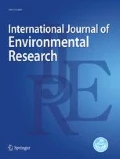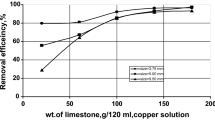Abstract
Nano-sized TiO2 particles containing anatase and rutile were applied to arsenic removal from water in natural groundwater conditions in the batch and column experiments. Arsenic concentrations were 200 µg L−1 and the pH range was 6–8.5 (similar to groundwater conditions). The results showed that anatase and rutile could adsorb 95.5% and 63.5% of arsenic in a solution after 60 min, respectively. In both adsorbents, arsenic adsorption was increased by increasing the adsorbent concentration. Increasing pH results increased adsorption in rutile more than anatase. The maximum adsorption capacity of 2.58 mg g−1 and 1.86 mg g−1 were calculated for anatase and rutile, respectively at the adsorbent concentration of 3 g L−1. Isotherm studies showed Freundlich model was more valid to the empirical adsorption data for both nanoparticles. The kinetics of the adsorption processes fitted well the pseudo-first-order adsorption model. To investigate the dynamic sorption, column study was carried out with fine and coarse silica sand porous media. According to the batch experiments, only anatase nanoparticles were injected into the column as an adsorbent at different doses. Breakthrough curves (BTC) showed the best efficiency of arsenic removal can be obtained by an adsorbent dose of 8 g L−1 in the fine sand column.
Article Highlights
-
TiO2nanoparticles (anatase and rutile) could be the effective adsorbent for reducing arsenic content from water.
-
The kinetic of the adsorption by rutile fitted well the pseudo-first-order adsorption model.
-
Anatase nanoparticle is more efficient than the rutile for the arsenic removal in groundwater conditions.
-
Anatase nanoparticle could be an instrumental agent for the in situ remediation in arsenic-contaminated aquifers.











Similar content being viewed by others
References
Al-Abdullah J, Al Lafi AG, Alnama T, Wa AM, Amin Y, Alkfri MN (2018) Adsorption mechanism of lead on wood/nano-manganese oxide composite. Iran J Chem Chem Eng 37:131–144
Ali I, Al-Othman ZA, Alwarthan A, Asim M, Khan TA (2014) Removal of arsenic species from water by batch and column operations on bagasse fly ash. Environ Sci Pollut Res 21:3218–3229
Aredes S, Klein B, Pawlik M (2012) The removal of arsenic from water using natural iron oxide minerals. J Clean Prod 29:208–213
Arsénio dS, Abreu AS, Moura I, Machado AV (2017) Polymeric materials for metal sorption from hydric resources. In: Water purification. Elsevier, pp 289–322
Bang S, Patel M, Lippincott L, Meng X (2005) Removal of arsenic from groundwater by granular titanium dioxide adsorbent. Chemosphere 60:389–397
Basha CA, Somasundaram M, Kannadasan T, Lee CW (2011) Heavy metals removal from copper smelting effluent using electrochemical filter press cells. Chem Eng J 171:563–571
Baskan MB, Pala A (2010) A statistical experiment design approach for arsenic removal by coagulation process using aluminum sulfate. Desalination 254:42–48
Carp O, Huisman CL, Reller A (2004) Photoinduced reactivity of titanium dioxide. Prog Solid State Chem 32:33–177
Chen L, He B-Y, He S, Wang T-J, Su C-L, Jin Y (2012) Fe-Ti oxide nano-adsorbent synthesized by co-precipitation for fluoride removal from drinking water and its adsorption mechanism. Powder Technol 227:3–8
Chen R, Zhi C, Yang H, Bando Y, Zhang Z, Sugiur N, Golberg D (2011) Arsenic (V) adsorption on Fe3O4 nanoparticle-coated boron nitride nanotubes. J Colloid Interface Sci 359:261–268
Chowdhury SR, Yanful EK (2010) Arsenic and chromium removal by mixed magnetite–maghemite nanoparticles and the effect of phosphate on removal. J Environ Manage 91:2238–2247
Cui J, Du J, Yu S, Jing C, Chan T (2015) Groundwater arsenic removal using granular TiO 2: integrated laboratory and field study. Environ Sci Pollut Res 22:8224–8234
Danish MI, Qazi IA, Zeb A, Habib A, Ali Awan M, Khan Z (2013) Arsenic removal from aqueous solution using pure and metal-doped titania nanoparticles coated on glass beads: adsorption and column studies. J Nanomater 2013:1–17
Deedar N, Aslam I (2009) Evaluation of the adsorption potential of titanium dioxide nanoparticles for arsenic removal. J Environ Sci 21:402–408
Dehvari M, Ehrampoush MH, Ghaneian MT, Jamshidi B, Tabatabaee M (2017) Adsorption kinetics and equilibrium studies of reactive red 198 dye by cuttlefish bone powder. Iran J Chem Chem Eng 36:143–151
Desta MB (2013) Batch sorption experiments: Langmuir and Freundlich isotherm studies for the adsorption of textile metal ions onto teff straw (Eragrostis tef) agricultural waste. J Thermodyn 2013:1–7
Donia AM, Atia AA, Mabrouk DH (2011) Fast kinetic and efficient removal of As (V) from aqueous solution using anion exchange resins. J Hazard Mater 191:1–7
Dutta PK, Ray AK, Sharma VK, Millero FJ (2004) Adsorption of arsenate and arsenite on titanium dioxide suspensions. J Colloid Interface Sci 278:270–275
Eljamal O, Sasaki K, Tsuruyama S, Hirajima T (2011) Kinetic model of arsenic sorption onto zero-valent iron (ZVI). Water Quality Exposure Health 2:125–132
Erickson BE (2003) Field kits fail to provide accurate measures of arsenic in groundwater. Int J Environ Sci Technol 37:35A-38A. https://doi.org/10.1021/es0323289
Fujishima A, Rao TN, Tryk DA (2000) Titanium dioxide photocatalysis. J Photochem Photobiol 1:1–21
Gupta K et al (2013) Effect of anatase/rutile TiO2 phase composition on arsenic adsorption. J Dispersion Sci Technol 34:1043–1052
Gupta SM, Tripathi M (2011) A review of TiO 2 nanoparticles. Chin Sci Bull 56:1639–1657
Hafeznezami S et al (2017) Remediation of groundwater contaminated with arsenic through enhanced natural attenuation: batch and column studies. Water Res 122:545–556
Hashemzadeh M, Nilchi A, Hassani AH, Saberi R (2019) Synthesis of novel surface-modified hematite nanoparticles for the removal of cobalt-60 radiocations from aqueous solution. Int J Environ Sci Technol 16:775–792. https://doi.org/10.1007/s13762-018-1656-4
Hiemstra T, van Riemsdijk WH (1996) A surface structural approach to ion adsorption: the charge distribution (CD) model. J Colloid Interface Sci 179:488–508. https://doi.org/10.1006/jcis.1996.0242
Ho Y-S (2006) Isotherms for the sorption of lead onto peat: comparison of linear and non-linear methods. Polish journal of environmental studies 15
Ho Y-S, McKay G (1999) Pseudo-second order model for sorption processes. Process Biochem 34:451–465
Ike M, Miyazaki T, Yamamoto N, Sei K, Soda S (2008) Removal of arsenic from groundwater by arsenite-oxidizing bacteria. Water Sci Technol 58:1095–1100
Jain A, Loeppert RH (2000) Effect of competing anions on the adsorption of arsenate and arsenite by ferrihydrite. J Environ Qual 29:1422–1430
Jegadeesan G, Al-Abed SR, Sundaram V, Choi H, Scheckel KG, Dionysiou DD (2010) Arsenic sorption on TiO2 nanoparticles: size and crystallinity effects. Water Res 44:965–973
Kamrani S, Rezaei M, Kord M, Baalousha M (2018) Transport and retention of carbon dots (CDs) in saturated and unsaturated porous media: role of ionic strength, pH, and collector grain size. Water Res 133:338–347
Kanel SR, Manning B, Charlet L, Choi H (2005) Removal of arsenic (III) from groundwater by nanoscale zero-valent iron. Int J Environ Sci Technol 39:1291–1298
Karmakar S, Bhattacharjee S, De S (2017) Experimental and modeling of fluoride removal using aluminum fumarate (AlFu) metal organic framework incorporated cellulose acetate phthalate mixed matrix membrane. J Environ Chem Eng 5:6087–6097
Katsoyiannis IA, Ruettimann T, Hug SJ (2008) pH dependence of Fenton reagent generation and As (III) oxidation and removal by corrosion of zero valent iron in aerated water. Int J Environ Sci Technol 42:7424–7430
Khelifi O, Nacef M, Affoune AM (2018) Nickel (II) adsorption from aqueous solutions by physico-chemically modified sewage sludge. Iran J Chem Chem Eng 37:73–87
Kocabaş-Ataklı ZÖ, Yürüm Y (2013) Synthesis and characterization of anatase nanoadsorbent and application in removal of lead, copper and arsenic from water. Chem Eng J 225:625–635
Ma L, Tu S (2011a) Removal of arsenic from aqueous solution by two types of nano TiO 2 crystals. Environ Chem Lett 9:465–472
Ma L, Tu S (2011b) Arsenic removal from water using a modified rutile ore and the preliminary mechanisms. Desalination Water Treatment 32:445–452
Malkoc E, Nuhoglu Y (2005) Investigations of nickel (II) removal from aqueous solutions using tea factory waste. J Hazard Mater 127:120–128
Mandal S, Mayadevi S (2008) Adsorption of fluoride ions by Zn–Al layered double hydroxides. Appl Clay Sci 40:54–62
Martinson CA, Reddy K (2009) Adsorption of arsenic (III) and arsenic (V) by cupric oxide nanoparticles. J Colloid Interface Sci 336:406–411
Moftakhar MK, Yaftian MR, Ghorbanloo M (2016) Adsorption efficiency, thermodynamics and kinetics of Schiff base-modified nanoparticles for removal of heavy metals. Int J Environ Sci Technol 13:1707–1722. https://doi.org/10.1007/s13762-016-0969-4
Mujawar MN, Sahu JN, Abdullah EC (2018) Synthesis of novel magnetic biochar using microwave heating for removal of arsenic from waste water. Iran J Chem Chem Eng 37:111–115
Naiya T, Bhattacharya A, Das S (2008) Removal of Cd (II) from aqueous solutions using clarified sludge. J Colloid Interface Sci 325:48–56
Özer A, Özer D, Özer A (2004) The adsorption of copper (II) ions on to dehydrated wheat bran (DWB): determination of the equilibrium and thermodynamic parameters. Process Biochem 39:2183–2191
Patra AK, Dutta A, Bhaumik A (2012) Self-assembled mesoporous γ-Al2O3 spherical nanoparticles and their efficiency for the removal of arsenic from water. J Hazard Mater 201:170–177
Pena ME, Korfiatis GP, Patel M, Lippincott L, Meng X (2005) Adsorption of As (V) and As (III) by nanocrystalline titanium dioxide. Water Res 39:2327–2337
Poorsadeghi S, Kassaee M, Fakhri H, Mirabedini M (2017) Removal of arsenic from water using aluminum nanoparticles synthesized through arc discharge method. Iran J Chem Chem Eng 36:91–99
Qiu S, Yan L, Jing C (2019) Simultaneous removal of arsenic and antimony from mining wastewater using granular TiO2: Batch and field column studies. J Environ Sci 75:269–276
Rahman MA, Hasegawa H (2011) Aquatic arsenic: phytoremediation using floating macrophytes. Chemosphere 83:633–646
Reed BE, Matsumoto MR (1993) Modeling cadmium adsorption by activated carbon using the Langmuir and Freundlich isotherm expressions. Sep Sci Technol 28:2179–2195
Sarici-Ozdemir C (2012) Adsorption and desorotion kinetcs methylene blue onto activated carbon. Physicochem Prob Min Process 48:441–545
Sen M, Manna A, Pal P (2010) Removal of arsenic from contaminated groundwater by membrane-integrated hybrid treatment system. J Membr Sci 354:108–113
Shakya A, Ghosh P (2018) Arsenic, iron and nitrate removal from groundwater by mixed bacterial culture and fate of arsenic-laden biosolids. Int J Environ Sci Technol 16:5901–5916
Sheshmani S, Arab FM, Amini R (2013) Iron (iii) hydroxide/graphene oxide nano composite and investigation of lead adsorption. J Appl Res Chem 6:17–23 ((in Persian))
Shojaei S, Shojaei S (2017) Experimental design and modeling of removal of acid green 25 dye by nanoscale zero-valent iron. Euro-Mediterranean J Environ Integration 2:2–15
Suteu D, Zaharia C, Badeanu M (2016) Kinetic modeling of dye sorption from aqueous solutions onto apple seed powder. Cellulose Chem and Technol 50:1085–1091
Tang X et al (2016) Chemical coagulation process for the removal of heavy metals from water: a review. Desalination Water Treat 57:1733–1748
Tian Y, Gao B, Wu L, Muñoz-Carpena R, Huang Q (2012) Effect of solution chemistry on multi-walled carbon nanotube deposition and mobilization in clean porous media. J Hazard Mater 231:79–87
Todd D, Mays L (2005) Groundwater hydrology third edition vol 3. Jhon Wiley and Sous,
Tsydenov DE, Shutilov AA, Zenkovets GA, Vorontsov AV (2014) Hydrous TiO2 materials and their application for sorption of inorganic ions. Chem Eng J 251:131–137
Wang JP, Qi L, Moore MR, Ng JC (2002) A review of animal models for the study of arsenic carcinogenesis. Toxicol Lett 133:17–31
WHO (2007) Arsenic in drinking water. Fact sheet No. 210 vol 12.
Xu P, Capito M, Cath TY (2013) Selective removal of arsenic and monovalent ions from brackish water reverse osmosis concentrate. J Hazard Mater 260:885–891
Yoon S-H, Lee JH, Oh S, Yang JE (2008) Photochemical oxidation of As (III) by vacuum-UV lamp irradiation. Water Res 42:3455–3463
Zhang B (2013) Removal of TiO2 nanoparticles by conventional water treatment processes. Clemson University
Acknowledgements
This research was part of a Ph.D. thesis conducted at Kharazmi University. The authors gratefully acknowledge the National Water & Wastewater Engineering Company of Iran for their technical support.
Author information
Authors and Affiliations
Corresponding author
Ethics declarations
Conflict of Interest
The authors state that they have no conflict of interest associated with this work.
Rights and permissions
About this article
Cite this article
Nazari, A., Nakhaei, M. & Yari, A.R. Arsenic Adsorption by TiO2 Nanoparticles Under Conditions Similar to Groundwater: Batch and Column Studies. Int J Environ Res 15, 79–91 (2021). https://doi.org/10.1007/s41742-020-00298-7
Received:
Revised:
Accepted:
Published:
Issue Date:
DOI: https://doi.org/10.1007/s41742-020-00298-7




